- Details
- Hits: 2052
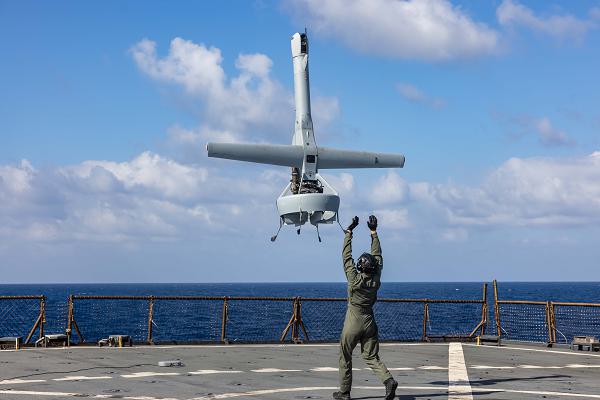
Mediterranean Sea. (March 15, 2024): When the Navy wants to look over the horizon, it sends out the V-BAT. In this photo by Marine Corporal Rafael Brambila-Pelayo, a V-BAT uncrewed aerial system launches from the dock landing ship USS Carter Hall to become the ship’s “eye in the sky”.
This unique drone gives situational awareness to commanders who use it for surveillance and intelligence gathering. It’s light weight (125 lbs.) which allows the system to be deployed by a 2-person team and packs up to fit in the back of a pickup truck. The system deploys quickly, going from package to flight in under twenty minutes.
Nine feet long with a ten-foot wingspan, the V-Bat can travel up to 56 mph for up to ten hours with a ceiling of 20,000 feet. What makes the unit remarkable are its electro-optical (EO)/mid-wave infrared (MWIR) cameras that provide long-range imaging abilities, image stabilization, and high-speed thermal imaging. The V-BAT can also transmit real-time video and imagery to its control station via a data link.
- Details
- Hits: 2277
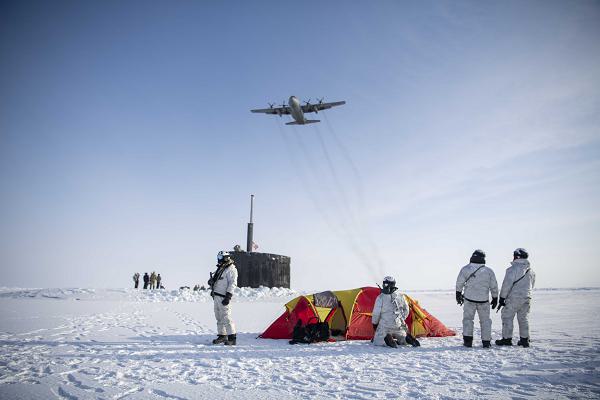
Undisclosed Location. Alaska. (March 9, 2024): Crashing a billion-dollar submarine through solid ice to the surface is no easy task. In this photo by MC1 Jeff Atherton, an Air Force C-130 Hercules flies over a group of Navy SEALs, Norwegian naval special operations commandos, and the attack submarine USS Hampton. The U.S. and Norwegian forces are participating in Arctic Edge, an annual exercise to test submarine capabilities in an Arctic environment.
For years, America’s Navy has used submarines to patrol the arctic seas beneath the ice at the top of the world. While the sea ice gives concealment from observation from above, it is necessary for submarines to punch through that ice to communicate, launch missiles, or support surface activity.
But how does a sub captain know where it is safe to surface?
- Details
- Hits: 1337
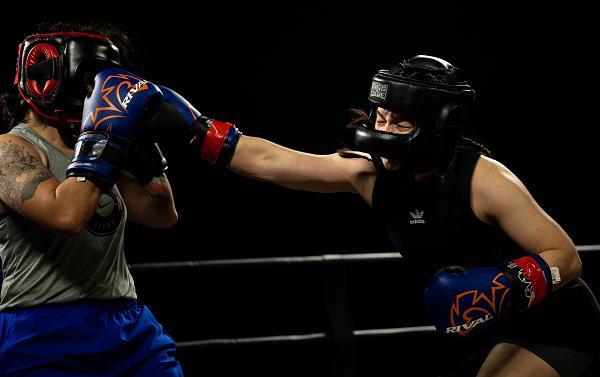
Al Udeid Air Base, Qatar. (March 9, 2024): As early as the first World War, American servicemembers have laced up their gloves and gone a few rounds to demonstrate their warrior spirit. In this photo by Technical Sergeant Alexander Cook, Air Force Senior Airman Lian Espinoza, assigned to the 379th Expeditionary Force Support Squadron, delivers a blow to her opponent during the Rumble in the Deid II boxing event. Espinoza belongs to a boxing fraternity who have served our nation including some of the sport’s brightest stars.
The military has long encouraged boxing as a form of self-defense training and as a means to build discipline or relieve tension among the troops. Its roots can be traced to President Theodore Roosevelt, an avid boxing enthusiast, who petitioned the senior military to hold boxing matches among the troops. During the World Wars, bouts were organized primarily among Sailors as a form of recreation and to boost morale.
Today, military boxers participate in base-wide, inter-service, and USA Boxing sanctioned amateur tournaments throughout the year and each service fields its own team.
Army Cadets at the U.S. Military Academy are required to take a boxing class as freshman and the West Point Boxing Team has produced a number of All-Army boxers. The Marines produced the first active-duty member to qualify for the Olympics in 1992 and the Air Force Falcons team has won an astounding 18 national championships.
Boxing will continue to be a vital tool to boost morale and fuel the warrior spirit in today’s military.
- Details
- Hits: 1043
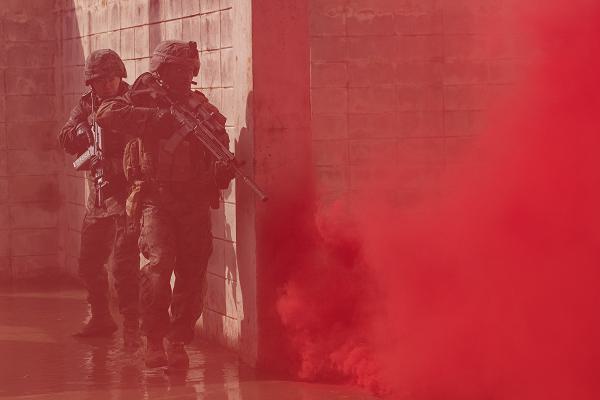
Camp Mujuk, Republic of Korea. (March 14, 2024): There is one environment where America’s mighty warplanes, powerful tanks, and high-tech weapons are virtually useless. In this photo by Lance Corporal Evelyn Doherty, Marine Corps Lance Corporal Ahmier Fillmore and a fellow Republic of Korea Marine navigate in close quarters combat during urban warfare training. It is combat in the cities that negates many of the advantages of modern militaries while offering significant advantages to the defenders.
Considered to be the most difficult form of warfare, fighting in urban areas is complicated by the presence of civilians, unfamiliar terrain, and the three-dimensional nature of the battlefield. Fighting in urban areas also negates the advantages that one side may have in armor, heavy artillery, or air support.
The U.S. Military is bound by the Geneva Conventions, the laws of war governing the amount of force which can be used in an area where there are known to be civilians. This necessitates severely limiting artillery and air support to limit civilian casualties. Worse for the attacking force, it is often difficult to distinguish civilians from other armed combatants such as militia groups and gangs. In fact, many times an enemy will deliberately blend with civilians to create a human shield for their forces.
- Details
- Hits: 826
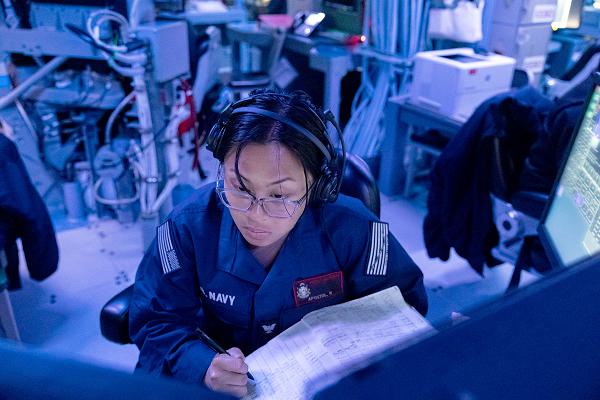
Philippine Sea. (March 1, 2024): With missiles flying in the Red Sea, the role of Navy Cryptologic Technicians (Crypto Techs) has never been more vital. In this photo by MC1 Devin M. Moore, Cryptological Technician 3rd Class Hannah Apostol, from Waipahu, Hawaii, stands watch in the combat information center aboard the Arleigh Burke-class guided-missile destroyer USS Rafael Peralta. Crypto Techs use high powered jamming signals to defeat enemy missile attacks such as those currently being fired by the Houthi Rebels in Yemen against U.S. forces.
These highly skilled professionals are experts at radar signals, electronic intelligence, and receiving and direction-finding systems. Aboard ship, Crypto Techs operate and maintain electronic sensors and computer systems while collecting, analyzing, and disseminating intelligence across the fleet. Most operate independently or are part of small groups working around the clock under extremely tense conditions. Their skill at detecting and jamming incoming missiles can literally mean life or death for the crew.
- Details
- Hits: 803
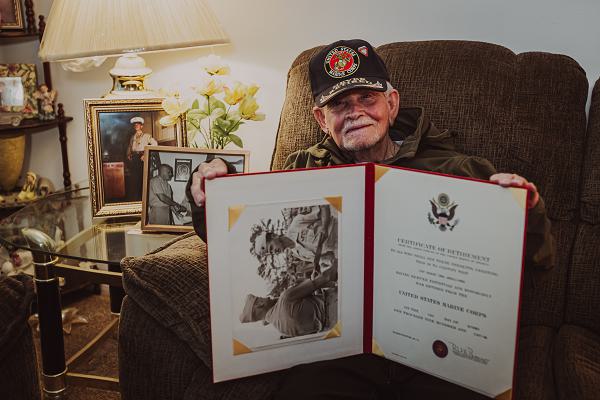
Jacksonville, North Carolina. (February 28, 2024): Very few Americans can claim credit for serving in two wars in one lifetime but there are always the few. In this photo by Lance Corporal Loriann Dauscher, 92-year-old retired Marine Corps Staff Sergeant Ismael Gonzalez-Ramos, a former infantry unit leader and decorated combat veteran, receives his certificate of retirement after twenty years’ service.
Originally from Cidra, Puerto Rico, SSgt. Gonzalez-Ramos enlisted in the Marines in 1951 and served in both the Korean and Vietnam Wars. He was decorated with the Bronze Star Medal with a Combat V device, the fourth highest military award for valor, while serving in jungles of Vietnam. During his time on active duty, he was stationed in Hawaii, California, Vietnam, South Korea, Japan, and Naples, Italy.
He recently celebrated his 65th wedding anniversary with his wife Ada and they have four children, eight grandchildren, and fifteen great grandchildren. Support Our Troops wishes SSgt. Gonzalez-Ramos a happy retirement after his long and faithful service to our nation.


